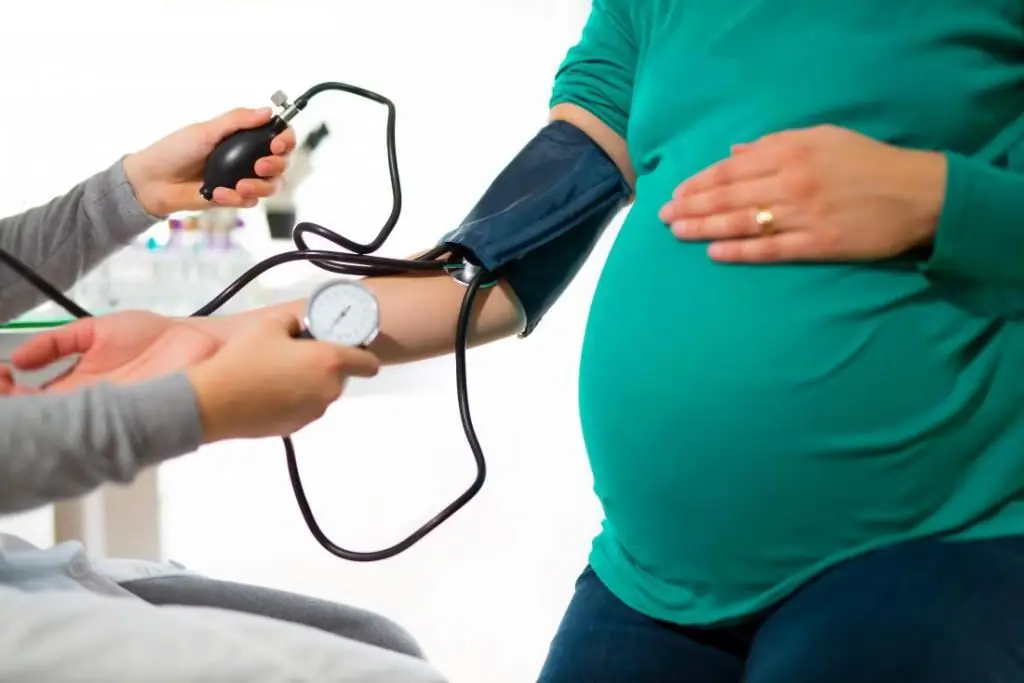2025 Author: Priscilla Miln | [email protected]. Last modified: 2025-01-22 17:55:29
With the onset of pregnancy, a woman is faced with a very large amount of new information for her. This applies, first of all, to her changed hormonal levels. To control it, a woman must take appropriate tests. One hormone to watch is free estriol.

The hormone estriol: what is it?
Estriol is a hormone that predominates in women. However, it can also occur in men, but in negligible amounts. Consequently, scientists attribute this hormone to a number of female ones. It belongs to the group of estrogens, which express increased activity in the second half of pregnancy, replacing progesterone.
Until the moment of conception, free estriol in a woman's body is inactive and prevails in small quantities. But after the onset of pregnancy, its role increases significantly. Along with progesterone, it has a supportive effect for bearing a child. That is why you need to constantly monitorits concentration in a woman's body.
Any fluctuation in the content of the hormone may indicate possible pathologies in the development of the fetus. Having passed special tests, you can determine, for example, placental insufficiency, missed abortion or premature detachment of the placenta. This allows you to take appropriate action as soon as possible.

What is estriol for?
This hormone is an important diagnostic feature for uteroplacental communication between mother and child. It is formed as a result of cholesterol entering the adrenal glands and liver of the child. In the process of complex biochemical transformations, the final product - estriol - penetrates the placenta. The further path of the hormone passes through the mother's circulatory system, then enters the liver, where it is processed and excreted in the urine.
The rate of free estriol performs the following functions during childbearing:
- affects the growth and formation of the uterine cavity;
- increases energy metabolism;
- controls the production of enzymes and processes in the uterus;
- affects uteroplacental blood flow;
- prepares the breast for the process of feeding the baby.
Estriol concentration study
In order to monitor the concentration of the hormone, it is necessary to take an analysis for free estriol. This study refers to the method of enzyme immunoassay in blood serum. You can do it in any laboratory that can provide you with this type of diagnosis. The direction for this study is issued by a gynecologist who has a pregnant woman registered. However, you can check the hormone content in the blood without a referral, you just need to know the name of the hormone being studied. The analysis is carried out mainly during the second screening, approximately for a period of 16-17 weeks.
In diagnostic medicine, the analysis for this hormone is designated as E3. The units of free estriol are ng/ml or nmol/l. For this analysis, venous blood is taken. You can get the diagnostic result the very next day.

Risk groups
There are certain factors, the presence of which requires more careful monitoring of the content of free estriol in a woman in position. Among them:
- blood relationship of parents;
- if future parents are over 35-45;
- presence of genetic pathologies in the family;
- if there have been miscarriages, abortions, miscarriages;
- exposure to parents of negative environmental factors (e.g. chemicals);
- hypertension or diabetes in a pregnant woman;
- expectant mother taking drugs that are dangerous to the fetus;
- presence of pathologies of fetal development;
- difficult pregnancy;
- Rhesus conflict.
How to prepare for the test?
In order for the indicator of unconjugated (free) estriol to be the most reliable, some requirements must be met before the study. Namely:
- give up fatty, s alty, smoked orspicy food;
- eliminate alcohol (which is unacceptable for a pregnant woman);
- the best option would be to take an analysis on an empty stomach;
- half an hour before the test, you need to calm down, relax and in no case do not smoke;
- if you are taking any medications, especially hormonal, then you should inform the diagnostician about this, as this may affect the result of the analysis.

Transcription of analysis
The best way to interpret the results is at a doctor's appointment. Having misunderstood any indicator, you can deliver yourself unnecessary worries and worries.
However, if you decide to check the level of free estriol during pregnancy on your own, without a doctor's referral, then you need to understand for yourself whether your hormone is normal or not. To do this, clinicians have created a table that indicates the norms at each stage of pregnancy.
| Gestational age | Normal hormone level (ng/ml) |
| 6-7 weeks | 0, 17-0, 72 |
| 8-9 weeks | 0, 23-1, 008 |
| 10-12 weeks | 0, 66-2, 44 |
| 13-14 weeks | 1, 64-4, 32 |
| 15-16 weeks | 1, 55-6, 04 |
| 17-18 weeks | 1, 9-7, 2 |
| 19-20 weeks | 2, 16-8, 06 |
| 21-22 weeks | 3, 45-11, 8 |
| 23-24 weeks | 2, 36-14, 68 |
| 25-26 weeks | 5, 76-17, 28 |
| 27-28 weeks | 6, 04-18, 28 |
| 29-30 weeks | 5, 76-19, 58 |
| 31-32 weeks | 5, 61-20, 16 |
| 33-34 weeks | 6, 62-23, 32 |
| 35-36 weeks | 7, 2-29, 08 |
| 37-38 weeks | 8, 64-32, 25 |
| 39-40 weeks | 10, 08-31, 96 |
Norm of free estriol during pregnancy
As we already mentioned, the level of this hormone will vary depending on the gestational age.
It is necessary to check the concentration and volume of the hormone in the blood at the same time, since the situation may change at different times of the day. The hormone reaches its highest concentration at 2-3 pm, so it is better to take the test on an empty stomach in the morning.
In the event that the level of free estriol corresponds to the norm (you can see in the table above), then nothing threatens your pregnancy, and it develops normally. But if it is reduced or, on the contrary, increased, you should undergo an additional examination to identify the pathology of pregnancy.

Deviations from the norm
Elevated levels of estriol can symbolize a multiple pregnancy, a large fetus, or liver disorders in the fetus. This indicator is not as common as low estriol.
If the indicator is lowered by 40% of the norm, then this can mean:
- risk of overwearing;
- presence of chromosomal abnormalities such as Down syndrome, Patau or Edwards syndrome;
- threatened miscarriage;
- presence of intrauterine infection;
- fetoplacental insufficiency;
- formation of a mole, etc.
However, it should also be taken into account that low free estriol may be due to antibiotics or hormonal drugs.

Triple screening test
As we wrote above, the analysis for unconjugated estriol is among the mandatory studies during the second screening, which is carried out within 14-20 weeks.
Triple screening test involves drawing blood from a woman in position to analyze the level of hCG, AFP and free estriol. This study allows you to calculate the risk of developing chromosomal diseases in the fetus, congenital malformations and the risk of fetal growth retardation. Let's break down this test into its components.
hCG (human chorionic gonadotropin) is a placental protein that begins to be produced immediately after implantation of the fetal egg in the uterus (approximately 4-5 days after fertilization). By the presence of this protein, you can understand whether pregnancy has occurred or not. This protein appears in the blood earlier than in the urine, so if you want to know about the onset of pregnancy as early as possible, you can get tested for this hormone at any diagnostic laboratory.
Low hCG can mean antenatal fetal death, threatened miscarriage, placental insufficiency or excessgestational age.
Elevated hCG indicates a multiple pregnancy, a mismatch in pregnancy, toxicosis, preeclampsia, or the presence of diabetes in a pregnant woman.
AFP (alpha-fetoprotein) - also refers to proteins. It is produced by the baby's liver and enters the mother's bloodstream. Diagnosis of the level of this protein is necessary for the timely detection in the fetus of defects in the nervous system, digestive and urinary systems, Shershevsky-Turner and Down syndromes, lag in the development of the child or impaired functioning of the placenta.
Decreased AFP levels can symbolize Down's syndrome, low placentation, the presence of diabetes or hypothyroidism in the expectant mother.

An elevated level of AFP means anomalies in the development of the nervous system (pathologies of the spinal cord, underdevelopment of the brain and its parts), which are fraught with the birth of a child with cerebral palsy or mental retardation, due to anomalies in the structure of the brain (anencephaly, macrocephaly, microcephaly, hydrocephalus, etc.). And there is also a risk of an unfavorable course of pregnancy, the threat of spontaneous abortion, oligohydramnios or missed pregnancy. High AFP levels are normal in multiple pregnancies!
E3 (free estriol) is a hormone produced by the placenta and liver of the fetus. It is necessary to assess the state of the uteroplacental circulatory system between mother and fetus.
Low EZ is a threat of miscarriage, prematurity or overmaturity, FPI, malnutrition or anemia in the fetus, intrauterineinfections.
High EZ is a large fetus or multiple pregnancy, the presence of kidney and liver diseases in the fetus. If the hormone rises too sharply, it may mean the risk of premature birth.
Change in one of the indicators has no diagnostic value. For a more complete analysis of the situation, programs are used that calculate the risks, taking into account the individual parameters of each pregnant woman.
Recommended:
Low hCG during pregnancy: rules for taking tests, deciphering the results, clinical norms and pathologies, effects on the fetus and consultations of gynecologists

Throughout pregnancy, a woman has to take a variety of tests and examinations many times. The initial test is blood for human chorionic gonadotropin. With it, it is determined whether there is a pregnancy. If you view the results in dynamics, you can note some pathologies and abnormalities in the development of the fetus. The results of such an analysis guide the doctor and outline the tactics of pregnancy management
Weight during pregnancy: norms and deviations. How not to gain weight during pregnancy

What should be the weight during pregnancy? It interests every mother. Many people worry not only about the full development of the baby in the womb, but also about their own figure. Why it is so important to eat right, and what a deficiency or excess weight gain can lead to when carrying crumbs, we will consider in the article
Heartburn during late pregnancy. Remedies for heartburn during early and late pregnancy

Heartburn during late pregnancy is extremely common. It affects about 85% of pregnant women. To alleviate the condition, it is important to know the factors that provoke a burning sensation in the esophagus
Hypotension during pregnancy: possible causes, symptoms, treatment, normal pressure during pregnancy, advice and recommendations from a gynecologist

What is hypotension during pregnancy? Is it a simple ailment, or a severe pathology that requires immediate medical attention? That is what we will talk about today. During the period of bearing a baby, every woman is faced with various ailments, because the body works "in three shifts", and gets tired in order. At this time, chronic diseases are exacerbated, and "sleeping" ailments are awakened, which could not be suspected before pregnancy
The thyroid gland and pregnancy: the effect of hormones on the course of pregnancy, norms and deviations, methods of treatment, prevention

The thyroid gland and pregnancy are very closely related, which is why it is important to timely diagnose and treat existing diseases of this organ. Pathologies can provoke various kinds of disorders and complications that adversely affect the condition of a woman and a child

